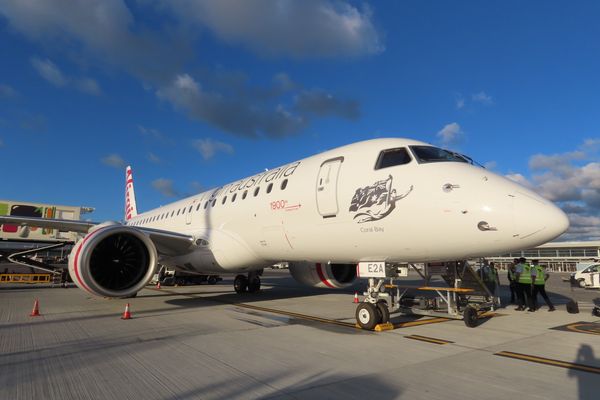Flying overnight seems advantageous. You board your flight, fly through the night, and arrive at your destination. You can probably even just sleep through the entire flight and not miss a beat when you land.
While that may be true for some, overnight flights often don’t work out perfectly.
And that’s why they are called red-eye flights.
But where did that term come from, and are there any pros to overnight flights? Let’s explore.
What’s a red-eye flight?
A red-eye flight is a term that has become synonymous with overnight flights that leave late in the evening and land at their destination early the next morning.
They are called “red-eye” because passengers are often tired and have red eyes from lack of sleep or trying to sleep in an uncomfortable position on the plane.

Red-eye flights are common on coast-to-coast routes in the United States, and international routes pass through several different time zones.
Why do airlines offer red-eye flights?
For an airline, red-eye flights offer several benefits from an operational standpoint.
Red-eye flights are cost-effective because they’re during off-peak hours, which can reduce airport-related fees like fuel and the demand for air traffic control. Plus, red-eye flights help airlines take advantage of less busy takeoff and landing slots because an airport won’t be as busy late at night or early in the morning.
Another benefit for an airline is that red-eye flights let them keep their airplanes, an expensive asset, in the air as much as possible. An airline doesn’t want their airplanes to sit idle when they could be flying, giving them a maximum return on investment.

Pros of Red-Eye Flights
Here are the four main pros of red-eye flights.
1. Time savings: By flying overnight, you could essentially save a day of travel. For this reason, business travelers are big fans of red-eye flights, as they allow them to maximize their time to the fullest.
2. Cheaper fares: Since they’re operating at non-ideal times that are less popular, red-eye flights are often lower in cost than typical daytime flights.
3. No airport crowds: Since fewer people want to fly at night, getting through the airport will likely be a breeze. There will likely be shorter lines at security and at boarding.
4. More relaxing flight: Red-eye flights can often be quieter because fewer people are on board. This could help create a more relaxing environment, which is especially advantageous if you want to sleep for the duration of the flight.

Cons of Red-Eye Flights
Of course, red-eye flights aren’t perfect. Here are four cons of red-eye flights:
1. Uncomfortable sleep: If you’re flying economy or coach, sleeping on an airplane could be quite uncomfortable, leading to poor sleep quality. You could feel exhausted on arrival and need to rest, negating any time-saving benefit you were hoping to take advantage of by flying overnight.
2. Jet lag: Flying overnight could disrupt your body’s circadian rhythm, leading to jet lag or sleep deprivation.
3. Limited services: With fewer passengers on board during red-eye flights, airlines often limit their in-flight services. That means meals and entertainment could be limited on a red-eye flight.
4. Arriving too early: If you have a hotel to check in to, red-eye flights may get you there hours before you can actually check-in.
Overall, you should decide if a red-eye flight is beneficial for you and your schedule.
Maiden Brazil: Virgin Australia Welcomes the Iconic Embraer E2 » China Eastern Inaugurates New World's Longest Flight »
Comments (0)
Add Your Comment
SHARE
TAGS
INFORMATIONAL Boeing Flight Aviation Airport Red eye flight Airbus Flying flightRECENTLY PUBLISHED
 Maiden Brazil: Virgin Australia Welcomes the Iconic Embraer E2
Known for its aging intrastate fleets and unmatched concentration of Fokker 100s, Perth Airport has been a time capsule for aviation enthusiasts. Now, Virgin Australia Regional Airlines is breaking tradition with the arrival of the cutting-edge Embraer E190-E2, ushering in a new era for Western Australian air travel.
TRIP REPORTS
READ MORE »
Maiden Brazil: Virgin Australia Welcomes the Iconic Embraer E2
Known for its aging intrastate fleets and unmatched concentration of Fokker 100s, Perth Airport has been a time capsule for aviation enthusiasts. Now, Virgin Australia Regional Airlines is breaking tradition with the arrival of the cutting-edge Embraer E190-E2, ushering in a new era for Western Australian air travel.
TRIP REPORTS
READ MORE »
 China Eastern Inaugurates New World's Longest Flight
China Eastern recently launched its longest flight, a route connecting Shanghai and Buenos Aires via a stopover in Auckland. Inaugurated in December, this was advertised as a “Direct Air Link” between Asia and South America.
ROUTES
READ MORE »
China Eastern Inaugurates New World's Longest Flight
China Eastern recently launched its longest flight, a route connecting Shanghai and Buenos Aires via a stopover in Auckland. Inaugurated in December, this was advertised as a “Direct Air Link” between Asia and South America.
ROUTES
READ MORE »
 Essential Legal Tips for Tourists Chartering a Yacht in Dubai
Discover how yacht rentals in Dubai are regulated and learn what every tourist should know about contracts, insurance, and taxes before setting sail.
TRIP REPORTS
READ MORE »
Essential Legal Tips for Tourists Chartering a Yacht in Dubai
Discover how yacht rentals in Dubai are regulated and learn what every tourist should know about contracts, insurance, and taxes before setting sail.
TRIP REPORTS
READ MORE »



